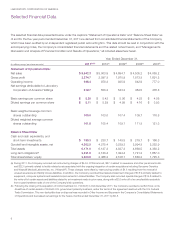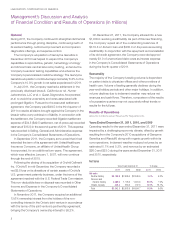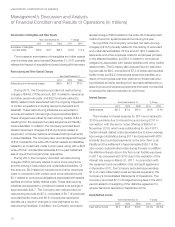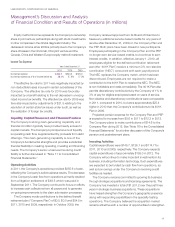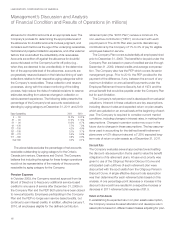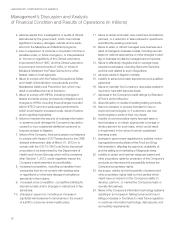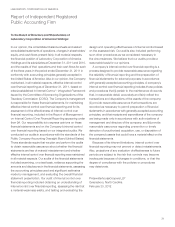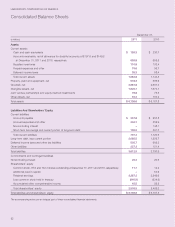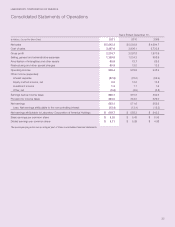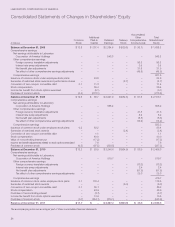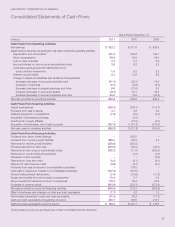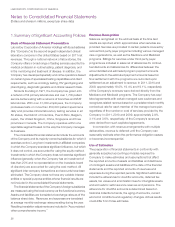LabCorp 2011 Annual Report Download - page 18
Download and view the complete annual report
Please find page 18 of the 2011 LabCorp annual report below. You can navigate through the pages in the report by either clicking on the pages listed below, or by using the keyword search tool below to find specific information within the annual report.
16
LABORATORY CORPORATION OF AMERICA
Management’s Discussion and Analysis
of Financial Condition and Results of Operations (in millions)
allowance for doubtful accounts at an appropriate level. The
Company’s process for determining the appropriate level of
the allowance for doubtful accounts involves judgment, and
considers such factors as the age of the underlying receivables,
historical and projected collection experience, and other external
factors that could affect the collectibility of its receivables.
Accounts are written off against the allowance for doubtful
accounts based on the Company’s write-off policy (e.g.,
when they are deemed to be uncollectible). In the determina-
tion of the appropriate level of the allowance, accounts are
progressively reserved based on the historical timing of cash
collections relative to their respective aging categories within
the Company’s receivables. These collection and reserve
processes, along with the close monitoring of the billing
process, help reduce the risks of material revisions to reserve
estimates resulting from adverse changes in collection or
reimbursement experience. The following table presents the
percentage of the Company’s net accounts receivable out-
standing by aging category at December 31, 2011 and 2010:
Days Outstanding 2011 2010
0 – 30 51.2% 51.1%
31 – 60 17.2% 17.5%
61 – 90 10.2% 9.7%
91 – 120 7.7% 7.2%
121 – 150 4.2% 4.0%
151 – 180 3.1% 3.7%
181 – 270 5.3% 5.8%
271 – 360 0.8% 0.9%
Over 360 0.2% 0.1%
The above table excludes the percentage of net accounts
receivable outstanding by aging category for the Ontario,
Canada joint venture, Clearstone and Orchid. The Company
believes that including the agings for these foreign operations
would not be representative of the majority of the accounts
receivable by aging category for the Company.
Pension Expense
In October 2009, the Company received approval from its
Board of Directors to freeze any additional service-based
credits for any years of service after December 31, 2009 on
the Company Plan and the PEP. Both plans have been closed
to new participants. Employees participating in the Company
Plan and the PEP no longer earn service-based credits, but
continue to earn interest credits. In addition, effective January 1,
2010, all employees eligible for the defined contribution
retirement plan (the “401K Plan”) receive a minimum 3%
non-elective contribution (“NEC”) concurrent with each
payroll period. The 401K Plan also permits discretionary
contributions by the Company of 1% to 3% of pay for eligible
employees based on service.
The Company Plan covers substantially all employees hired
prior to December 31, 2009. The benefits to be paid under the
Company Plan are based on years of credited service through
December 31, 2009, interest credits and average compensa-
tion. The Company also has the PEP which covers its senior
management group. Prior to 2010, the PEP provided for the
payment of the difference, if any, between the amount of any
maximum limitation on annual benefit payments under the
Employee Retirement Income Security Act of 1974 and the
annual benefit that would be payable under the Company Plan
but for such limitation.
The Company’s net pension cost is developed from actuarial
valuations. Inherent in these valuations are key assumptions,
including discount rates and expected return on plan assets,
which are updated on an annual basis at the beginning of each
year. The Company is required to consider current market
conditions, including changes in interest rates, in making these
assumptions. Changes in pension costs may occur in the
future due to changes in these assumptions. The key assump-
tions used in accounting for the defined benefit retirement
plans were a 4.0% discount rate and a 7.25% expected long-
term rate of return on plan assets as of December 31, 2011.
Discount Rate
The Company evaluates several approaches toward setting
the discount rate assumption that is used to value the benefit
obligations of its retirement plans. At year-end, priority was
given to use of the Citigroup Pension Discount Curve and
anticipated cash outflows of each retirement plan were
discounted with the spot yields from the Citigroup Pension
Discount Curve. A single-effective discount rate assumption
was then determined for each retirement plan based on this
analysis. A one percentage point decrease or increase in the
discount rate would have resulted in a respective increase or
decrease in 2011 retirement plan expense of $1.8.
Return on Plan Assets
In establishing its expected return on plan assets assumption,
the Company reviews its asset allocation and develops return
assumptions based on different asset classes adjusting for plan


